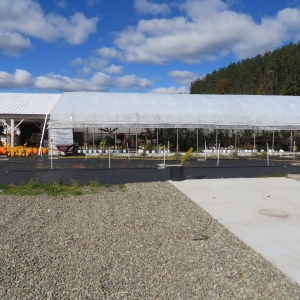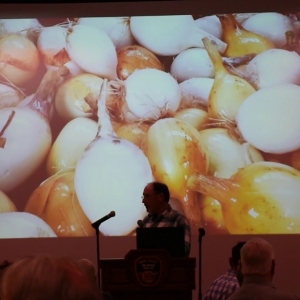Other Ag News: How the Government Shutdown is Impacting Farmers
The transition from one fiscal year to the next is not something that typically dominates headlines. In fact, as the calendar turns from September 30 to October 1 – when the federal government begins a new fiscal year – the less attention the better. Yet when Congress and the President are unable to reach an agreement on government funding, the start of a new fiscal year can bring with it tremendous impacts.
During a government shutdown some federal services will remain in operation, while others may go dark, and the longer the shutdown lasts, the more severe the disruptions become. This year, Congress and President Trump failed to reach an agreement to fund the government beyond September 30, 2025 – and as a result the government has largely closed. The President and Congressional Republicans have proposed to fund the government beyond September 30 with what’s known as a “clean” continuing resolution (CR) – simply put, to continue funding the government at the same level (H.R.5371). Congressional Democrats, meanwhile, have called for a CR that funds the government and extends Affordable Care Act (ACA) subsidies to prevent healthcare costs from skyrocketing for millions of Americans later this year (S.2882).
Access to critical services – such as reliable internet – can be challenging or even nonexistent in many parts of rural America. Unfortunately, this also extends to access to reliable and affordable health care. On average, individuals – including farmers – living in rural households are more likely to be uninsured. Yet the rate of uninsured adults under 65 in rural areas has dropped by nearly half since 2010, when the ACA was passed, and there’s reason to believe uninsured rates may have fallen even more steeply for farmers since the ACA’s enactment. Healthy, thriving farmers, families, and rural communities are a foundational component of a sustainable, just food and farm system – and ensuring that all Americans can access quality, affordable healthcare is a critical part of reaching that goal.
In addition to the government shutdown, the Agriculture Improvement Act of 2018 – otherwise known as the 2018 Farm Bill – expired with the new fiscal year, bringing with it an additional set of uncertainties. The rest of this blog post explores the impacts of the government shutdown and the expiration of the 2018 Farm Bill on farmers and food system stakeholders nationwide.
Government ShutdownWhether you realize it or not, federal programs and services are a part of many peoples’ daily lives. The US Department of Agriculture (USDA), with employees around the country currently totaling around 80,000, offers hundreds of programs in communities nationwide that support farmers and ranchers, rural businesses, and other food system stakeholders. With roughly half of USDA’s staff furloughed as a result of the shutdown, the impacts are sure to be felt widely. However, these shutdown impacts cannot be viewed in isolation. In fact, for the nine months prior to the government shutdown, many of the programs and services that USDA offers have been under threat as funding has been frozen and abruptly – actions resulting in devastating consequences for farmers and rural communities. As with anything, context is important.
USDA has dramatically reduced its staff in recent months. Since January 2025, the Department has already lost at least 18,000 employees. More than 15,000 USDA employees left the department through the “Department of Government Efficiency (DOGE)”’s so-called Deferred Resignation Program (DRP). The DRP offered federal employees fully paid administrative leave through September 2025 if employees voluntarily resigned from their positions. Approximately 3,876 USDA employees accepted DOGE’s first round DRP offer, and an additional 11,298 USDA employees resigned in the second round of DRP. Many of these employees have years of experience and irreplaceable expertise. The staff losses are impacting research, conservation, the farm safety net, and more.
Beyond staff losses, Secretary of Agriculture Brooke Rollins announced this summer a proposed USDA reorganization. This proposed reorganization was drafted without any consultation with farmers or other stakeholders. While the reorganization plan does not directly include planned layoffs or reductions in force (RIF), it would in all likelihood result in the loss of thousands more staff if office relocations and consolidations are carried out. Recent history shows that staffing losses directly reduce and delay USDA’s services to stakeholders. As of posting, the reorganization remains a proposal that has yet to be finalized or implemented. But if it is implemented as proposed, the impacts are likely to be severe, lasting long after the shutdown ceases. Find NSAC’s in depth comment on the reorganization here.
Finally, just prior to the start of the current government shutdown, the Office of Management and Budget (OMB) distributed a memo to federal agencies encouraging them to consider firing employees during the government shutdown by specifically targeting staff who work on programs that were out of alignment with the President’s priorities. The memo was swiftly met with multiple legal challenges and as of posting, no RIFs have taken place during the current government shutdown.
So, against the backdrop of broken funding agreements, staff firings, a reorganization proposal, and the spectre of more firings – all of which have either reduced USDA’s capacity to serve its stakeholders or threatened to do so – the federal government has shut down. This post looks at what that means for agricultural conservation, the farm safety net, nutrition, research, local and regional food systems, and food safety.
Broadly speaking, federal staff are only allowed to continue working during a shutdown if they are “excepted” – either they are somehow essential to the operations and mission of the agency, or their job is funded through a non-lapsed funding source. On September 30, 2025, USDA published its Lapse of Funding Plan, which details agency-by-agency shutdown plans, from furloughed staff to services that will lapse – and is the basis for our analysis below.
ConservationRoughly 99% of the Natural Resources Conservation Service (NRCS) staff is located outside the National Capitol Region (NCR), which means they are overwhelmingly state-based to provide technical assistance directly to producers. Further, a significant portion – roughly a third – of the NRCS budget for that technical assistance comes from mandatory funding for conservation programs. In theory, this means producers should still have some limited access to NRCS staff and the financial assistance provided by conservation programs at this time. However, shutdown plans provided by the agency, and early reports from our members in the field, indicate the reality is far less clear. According to NRCS’ shutdown plan:
- 95.799% of the remaining 9,237 employees are furloughed. It’s worth noting that, prior to the shutdown, nearly 1 in 4 NRCS employees left the agency this year.
- Services continuing during a shutdown:
- NRCS will continue agency operations using available funding, including fiscal year (FY) 2026 mandatory farm bill programs funds, as well as prior year carryover discretionary and mandatory funding, to implement NRCS services and programs at USDA service centers and offices.
- Services stopping during a shutdown:
- Key operational activities such as processing of contract payments to farmers and ranchers, conservation planning activities, ongoing collaborative projects with key soil and conservation partners, and processing of payments for outstanding contracts and agreements
- Advancing Markets for Producers (AMP) amendments in process of being signed are now further delayed.
The shutdown plan presents an inherent contradiction. It correctly claims NRCS has the needed mandatory resources to continue providing some level of service to producers, but furloughs nearly every single employee, making it impossible to do so. As a result, farmers will likely (or may have already) go without a planned annual payment, a reimbursement for work already completed, or certainty from NRCS on how to complete fall field work to remain in compliance with existing contracts. This approach is needlessly disruptive and burdensome for farmers who are facing the same dismal economy as their neighbors, but have elected to do the hard work of improving conservation efforts within their operation anyway.
Farm Safety NetThe Farm Service Agency (FSA) – the primary agency responsible for administering farm safety net programs – is broadly impacted by the shutdown with a majority of its staff furloughed. Staff in county offices around the country will be largely unavailable for farmers seeking to access loans, commodity and other program payments, and disaster assistance. At a moment when producers across the country are facing significant financial challenges, many programs designed to provide such economic relief will be inaccessible due to the shutdown.
- 67% of FSA staff are furloughed
- Services Continuing During a Shutdown:
- After 10 days of a shutdown, each county office will have one loan employee and one farm program employee on call to complete certain loan processing items: continuing liens, protective advances, and bankruptcy notification responses.
- Services Lapsing During a Shutdown:
- All disaster assistance payments, including remaining Supplemental Disaster Assistance programs
- Processing annual CRP payments
- Processing annual ARC/PLC payments
- Accepting and processing of new loans
- Other credit or loan activities, including providing advance funds, obligating or closing direct loans previously approved, processing or approving debt settlement applications, processing guaranteed loss claims, and loan restructuring.
More than 40 million people and 29 million students rely on USDA nutrition programs, such as the Supplemental Nutrition Assistance Program (SNAP), the Special Supplemental Nutrition Program for Women, Infants and Children (WIC), and child nutrition programs. These essential nutrition resources will remain available during a shutdown, subject to the availability of funding. In this case, families will still have access to their SNAP benefits and schools will have access to foods through entitlement offerings; however, funding for WIC benefits is expected to run out very soon, impacting roughly 6 million pregnant people and parents with young children.
- 91.7% of USDA’s Food and Nutrition (FNS) staff have been furloughed.
- Services continuing during a shutdown:
- FNS will designate staff to manage program administration of SNAP benefits between state agencies, but the number of staff available is unclear.
- School menus and purchases are largely planned before the school year begins. Schools should continue to have access to USDA foods and meal reimbursements since these funds are made available through a transfer of funds from Section 32, which can be drawn at any time.
- While it is reassuring that the majority of nutrition benefits will continue to be available for families and children, the extent to which these programs will run smoothly with so many staff furloughed is still unknown.
- Services lapsing during a shutdown:
- While existing authorized vendors will be able to accept and benefit from SNAP benefits, USDA will not process any new applications for vendors seeking to accept SNAP or WIC applications.
- Additional technical assistance or support services, such as offering webinars, will not continue during a shutdown. This is particularly relevant for current Patrick Leahy Farm to School Grant applications that are due in early December.
The shutdown not only impacts the work USDA does that directly serves producers, but also the research that underpins every aspect of farm viability and success. USDA’s Research, Education, and Economics mission area – which houses the Agricultural Research Service (ARS), Economic Research Service (ERS), National Agricultural Statistics Survey (NASS), and the National Institute of Food and Agriculture (NIFA) – is tasked with providing reliable scientific research, data, and analysis for America’s farmers, ranchers, rural communities, and other stakeholders. These research staff and sites provide the human capital and infrastructure for agricultural research, as well as data collection and analysis for commodities and rural communities.
Many competitive grant programs within NIFA, like the Organic Research and Extension Initiative, Food Safety Outreach Program, and the Beginning Farmer and Rancher Development Program, are already running nearly a full year behind their normal grant cycle even prior to the shutdown. The shutdown will further delay the agencies in opening up funding opportunities for these programs, exacerbating uncertainty for farmers and researchers who are already reeling from frozen and terminated funding agreements since the start of this Administration.
- 69% of ARS Staff Furloughed
- Services continuing during a shutdown:
- Protection of human and animal life as well as research property and data where significant damage could result
- Research on Highly Pathogenic Avian Influenza, New World Screwworm, and other vital research needs that are essential to protecting public health and safety
- Services stopping during a shutdown:
- Citrus Greening
- Animal/crop production and protection projects and food safety research
- Services continuing during a shutdown:
- 94% ERS Staff Furloughed
- No public facing work at ERS will continue during shutdown
- ERS will suspend almost all program activities. ERS publications, website updates, and data products, will be suspended during a lapse in appropriations
- 95.6% NIFA Staff Furloughed
- Continuing: financial and grants management support as needed
- All program activity will cease
In addition, 91% of NASS employees and the entire Office of the Chief Scientist, except for the Chief Scientist themselves, are furloughed, along with a suspension of all NASS data releases.
Local and Regional Food SystemsUnlike other agencies within USDA, staff and operations at the Agricultural Marketing Service (AMS) – one of the primary agencies that supports local food system efforts – are largely funded by associated program fees and mandatory farm bill funding. As a result, many AMS programs and functions can continue during a shutdown. The status of other programs utilizing funds from the American Rescue Plan Act (ARPA) remain unclear.
However, this is not the case for Rural Development (RD). While the RD budget is small in comparison to AMS, it runs a number of impactful business development programs with staff located in every state. This includes the Meat and Poultry Processing Expansion Plant grant Program and the Value-Added Producer Grant program, among others.
- 8.72% of AMS staff are furloughed.
- Services continuing during a shutdown:
- A number of activities that allow for products to reach markets, such as food product grading and specialty crop inspections, will continue uninterrupted.
- Commodity and food purchases, directed by FNS and other agencies, will continue.
- There are a number of Farm Bill programs that have mandatory funding, such as the Farmers Market and Local Food Promotion Programs, that should be unaffected.
- Services lapsing during a shutdown include:
- Grant programs funded by annual appropriation
- National Organic Program; Country of Origin Labeling; Packers and Stockyards Program; Pesticide Data Program; National Bioengineered Food Disclosure
- Other programs not funded by mandatory funds may also halt such as the Meat and Poultry Processing Technical Assistance program or the Local Meat Capacity grant program
- 83% of Rural Development (RD) staff have been furloughed.
- Services continuing during a shutdown:
- The extent of activities that will continue will be those focused on protecting government assets or property. In this case, that includes home and farm loan programs, in which the government has a vested interest in collecting payments from borrowers.
- Services lapsing during a shutdown:
- Although RD programs are authorized by the farm bill, the majority of business development RD activities are funded through annual appropriations and as a result will stop during a shutdown. These include programs such as the Rural Microentrepreneur Assistance Program, Rural Business Development Grants, and Appropriate Technology Transfer for Rural Areas (ATTRA).
- Meat and Poultry Processing Expansion Program (MPPEP) grants that have not been fully paid out are likely paused.
A large portion of USDA’s Food Safety and Inspection Service (FSIS) and the Food and Drug Administration (FDA)’s staff, with their core missions of food safety, are exempted or excepted from the shutdown. However, even within this core mission, many of their services are reduced, defaulting to a more reactive position. Across both agencies, non-mandatory policy initiatives – such as those that provide extra guidance to small farms or small processors – will be paused. While these activities are not mandatory, they are of critical importance to those small businesses that rely on them.
Across both agencies, state cost-share funding will follow the model of federal activities and narrow in on key inspection activities as well. It is unclear from the contingency plans of both FDA’s Human Foods Program and FSIS whether the overall payment of these state cost shares will cease, though the FSIS contingency plan does mention the potential for this to happen whereas the FDA does not.
The lapse in support for services and programs that benefit small farmers and processors means that parts of the industry often most in need of tailored support may feel the impacts of the shutdown disproportionately, further delaying needed progress in food safety improvements.
- 7% of FSIS staff are furloughed.
- Services continuing during shutdown:
- FSIS will continue to perform mission-essential food safety operations required to protect life and property, including statutorily required inspection of meat, poultry, and egg products, investigations necessary to protect public health (outbreaks, recalls, etc.), laboratory work essential to identifying public health concerns and threats, emergency preparedness, and minimum levels of other support functions necessary to maintain these activities. Additionally, mandatory administrative work related to the shutdown will also continue.
- Services stopping during the shutdown: All functions not required to directly or indirectly support the protection of life and property will cease. This includes non-essential administrative tasks, training other than mandatory training for frontline inspectors, and other support activities.
- Cooperative Agreements for Inspection Services: States may run out of funds to perform key inspection services. A total of 29 states run Meat and Poultry Inspection (MPI) programs.
- Policy initiatives, including those that impact small and very small plants, are stalled.
According to FDA’s lapse plan, 13,872 (86%) of FDA staff will be retained, including 10,740 (66%) who are exempt from furlough because their activities or position are already funded or otherwise exempted and 3,132 (19%) who are excepted because their activities are deemed necessary by implication or for the safety of human life or protection of property).
- Services continuing during shutdown:
- All FDA activities related to imminent threats to the safety of human life or protection of property would continue. This includes detecting and responding to public health emergencies and continuing to address existing critical public health challenges by managing recalls, mitigating drug shortages, and responding to outbreaks related to foodborne illness and infectious diseases. It also includes surveillance of adverse event reports for issues that could cause human harm, the review of import entries to determine potential risks to human health, conducting for cause and certain surveillance inspections of regulated facilities, and related regulatory testing activities, and criminal enforcement work and certain civil investigations.
- Services stopping during shutdown:
- Food safety efforts within FDA’s Human Foods Program (HFP) are reduced to safety surveillance and emergency responses. Longer-term food safety initiatives, including policy work to help prevent foodborne illnesses and diet-related diseases, would be halted, jeopardizing public health.
- FDA will be limited in the number and type of inspections to be conducted, unless the inspections are for cause or otherwise necessary to detect and address imminent threats to the safety of human life, or can be conducted with carryover user fee funding.
USDA’s National Appeals Division (NAD) is an independent office that presides over appeals of adverse decisions stemming from the Natural Resources Conservation Service, the Farm Service Agency, the Risk Management Agency, and Rural Development. When a farmer or other stakeholder disputes a decision made by one of those agencies, they generally may appeal the decision to NAD for review and potential reversal.
During the shutdown, 100% of Office of Hearing and Appeals (OHA) staff are furloughed and all NAD proceedings are postponed. Given first the funding freeze and then the unprecedented and abrupt cancellation of countless agreements between the USDA and farmer-serving organizations under this Administration, the shutdown will further delay farmers and other stakeholders from obtaining the relief they seek. When the government reopens, there will likely be additional delay resuming postponed proceedings given how many appeals have been filed under the Administration challenging the lawfulness of recent decisions, on top of NAD’s regular docket.
Farm Bill ExpirationAmidst all of the uncertainty outlined above, it would be understandable if you lost track of the farm bill’s status. While the 2025 budget reconciliation bill (OBBB, P.L. 119-21) reauthorized some programs from the traditional farm bill, it excluded the vast majority of farm bill programs, leaving them to an uncertain future. Consequently, on October 1, 2025, the Agriculture Improvement Act of 2018 – more commonly known as the 2018 Farm Bill – expired.
Close observers of federal food and agriculture policy will be familiar with the oft-repeated albeit misleading message that the impacts of an expired farm bill don’t really kick in until January 2026, with the start of the new crop year. While it is true that there are new and significant impacts beginning in the new year, the consequences of allowing the 2018 Farm Bill to expire without a replacement begin immediately.
Note: the farm bill expiration impacts discussed below are anticipated impacts when the government is funded and open. During a government shutdown, the impacts in this section are superseded by and in addition to the impacts of a government shutdown.
ConservationWith one major exception, key USDA conservation programs – Conservation Stewardship Program (CSP), Environmental Quality Incentives Program (EQIP), Agriculture Conservation Easement Program (ACEP), and the Regional Conservation Program (RCPP) – should remain largely unaffected by the expiration of the farm bill. This is a direct result of the Inflation Reduction Act (IRA), which invested in and reauthorized these programs through 2031. However, the Conservation Reserve Program (CRP) is not so lucky.
Administered by the Farm Service Agency (FSA), CRP conserves and improves soil, protects water quality, and provides wildlife habitat by establishing long-term cover on highly erodible land or land in need of conservation buffers that has previously been in row crop production. In exchange for cost-share and rental payments, farmers remove environmentally sensitive land from production and plant resource-conserving land cover to protect soil, water, and wildlife habitat.
CRP’s statutory authorization lapsed along with the rest of the farm bill on September 30, and therefore no new work can occur within that program without action from Congress to extend the prior or reauthorize a new farm bill. Effective as of October 1, 2025:
- FSA will not approve new CRP contracts for any signup types
- FSA will not process offers for enrollment in CRP for all signup types
- FSA will not authorize any CRP contract revisions or corrections
- Contracts that were approved on or before September 30 will receive annual rental and cost-share payments, and signing incentive and practice incentive payments, as applicable.
Local and Regional Food Systems
Due to NSAC member advocacy during the 2018 Farm Bill, many local and regional food system programs now have permanent mandatory baseline funding and therefore should not see a significant interruption following the expiration of the 2018 Farm Bill on October 1, 2025. However, for programs such as the Local Agriculture Market Program (LAMP), that have not yet awarded FY2025 Farmers Market and Local Food Promotion Program and Regional Food System Partnership Grants, it’s possible that grant cycles could be interrupted during the lapse in authorization. For the Senior Farmers’ Market Nutrition Program (SFMNP), while states should be able to finish programming without interruptions for the remainder of the 2025 season, the programs’ operations could be impacted in calendar year 2026 if there is a significant delay in a farm bill reauthorization or extension.
Organics and ResearchA handful of critical farm bill programs are funded without mandatory “permanent” baseline funding, meaning that without a provision that specifically offers continued funding, funding for the programs would expire when the farm bill expires. Despite its faults, OBBB provided additional funding for several of these formerly “stranded” programs, meaning they will remain funded during a short term lapse in farm bill authority.
One such program is the National Organic Certification Cost Share Program (OCCSP), which supports farmers with their annual certification costs. The Organic Production and Market Data Initiatives (ODI) and Scholarships for 1890s Institutions also both received additional funding through OBBB and should not be impacted by the lapse in authorization.
Farming Opportunities Training and OutreachThe Farming Opportunities Training and Outreach (FOTO) program, which is a combination of the Beginning Farmer and Rancher Development program (BFRDP) and the Outreach and Assistance to Socially Disadvantaged and Veteran Farmers and Ranchers Program (2501), was created in the 2018 Farm Bill in part to secure mandatory baseline funding for both 2501 and BFRDP. Many competitive grant programs within NIFA, like FOTO, are already running nearly a full year behind their normal grant cycle and saw no RFA for the FY25 grant cycle. Despite mandatory funding for the program continuing, the statutory authority for the grant program lapsed on October 1, 2025. Therefore, like LAMP discussed above, absent an extension or reauthorization, the next grant cycle may be interrupted.
Farm Safety NetBy and large, the farm safety net – ranging from credit to crop insurance and commodity programs – should continue to operate with little interruption through the end of 2025.
The Federal Crop Insurance Program – which is permanently authorized and funded at such sums as necessary in perpetuity by Congress – will continue to function without interruption in the absence of a farm bill reauthorization or extension. Permanent disaster programs, including the Noninsured Crop Disaster Assistance Program and programs to support livestock and fruit tree producers, are also authorized to continue.
The farm bill also permanently authorizes USDA to make and guarantee loans, for which money is allocated by Congress in the annual appropriations process. Failure to reauthorize or extend the farm bill is not likely to impact the availability or servicing of farm loans.
Several commodity programs – including Price Loss Coverage (PLC), Agricultural Risk Coverage (ARC), Dairy Margin Coverage (DMC), and marketing assistance loans – were amended and extended through 2031 in the 2025 budget reconciliation bill. Changes to reference prices in ARC/PLC will be implemented for the 2025 crop year, with payments calculated on these new reference prices set to be administered in Fall 2026.
However, if the farm bill is not reauthorized or extended by January 1, 2026, these commodity programs will begin to be replaced with “permanent law,” or non-expiring provisions established in the 1938 and 1949 Farm Bills. The first commodity to be impacted is dairy. While the reconciliation bill amended these commodity programs, a suspension of permanent law was not included in the final legislation. Therefore, a reauthorization or extension of the farm bill prior to January 1, 2026, is necessary to prevent these programs from reverting to permanent law.
What’s NextThis year has presented farmers with an unprecedented set of obstacles to navigate. While there is a long way to go, the final months of 2025 nonetheless offer an opportunity to bring much needed stability after months of chaos – by ending the government shutdown, enacting FY2026 agriculture appropriations, and passing a farm bill extension if a strong and fair farm bill cannot be achieved this year.
The post How the Government Shutdown is Impacting Farmers appeared first on National Sustainable Agriculture Coalition.
Signup for the Ag Newsletter
Get the freshest farm news, events and updates from in and around Cattaraugus County, NY at least once a month! Go signup!
Other ways to stay connected:
Get Involved in Farming
Resources for Starting a Farm in Cattaraugus County
Profile of Cattaraugus County soils
Agriculture Career Exploration
Questions about farming? Find out Who to Call











